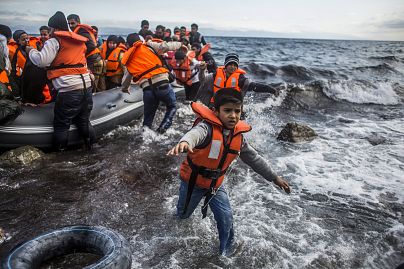One thing's for sure: The EU desperately needs a better policy to deal with undocumented migrants.
By Jennifer Clark
Europe's leaders have taken a small step towards a common migration policy with their agreement on June 28 to set up "controlled centers"scattered around the European Union. The centers will house and process asylum seekers, shifting the full burden away from frontline countries Italy, Spain and Greece. But these centers are a long way from a permanent solution in the Mediterranean. To manage the chaotic and politically explosive undocumented migrants problem, does the EU need its own version of Ellis Island?
Under the plan hammered out at an all-night summit at the end of June, migrants rescued at sea will be transported to EU nations hosting these centers where those characterized as qualified to seek asylum will be separated from economic migrants. Economic migrants without papers arriving along with them will be returned to their home countries. Documented immigrants arriving by air or across land borders will continue to be dealt with through national laws as usual.
Many of the details remain unclear, but one thing's for sure: The EU desperately needs a better policy to deal with undocumented migrants. Already around a thousand people died so far this year making the dangerous ocean crossing, according to the U.N.'s migration agency, cramming onto unsafe boats often run by human traffickers who prey on the poor and desperate.
This uncontrolled flow of undocumented people, which peaked in 2015 with around one million arrivals, also resulted in the populist surge that has turned European politics upside down. And yet, the number of "illegal" migrants has dropped 95 percent from the 2015 peak, after the route from Turkey to Greece was shut following an EU deal with Turkey in 2016. Italy's controversial accord last year with Libya's militias has also reduced arrivals at its southern shores.
"It's not the numbers themselves, it's the mismanagement," Beppe Severgnini, editor of Italian news weekly Corriere Sette, told me recently. "The system is all wrong. There's a long limbo while asylum-seekers wait for their papers. And a lot of them just hand around in parks. People don't understand."
Hence the need for a more organized and perhaps more centralized EU approach to deal with both regulated and illegal immigration. The Ellis Island comparison is not as far from the mark as it seems. In 2014, levels of legal immigration into the EU actually overtook thoseof the U.S., according to Francois Heron, former head of France's national demographics institute INED. Two million non-EU citizens migrated to the EU in 2016, according to Eurostat, compared to the 1.1 million immigrants who received a "green card" in the U.S.
Ellis Island was created in 1892 as part of a broader "open door" policy designed to deal with increasing immigration and solve the Industrial Revolution's need for legal immigration bringing cheap labor through social engineering. The U.S. federal government took control of immigration processing from the states creating Ellis Island to interview people as efficiently as possible, weeding out those who had diseases or who otherwise appeared unable to contribute to society. Certainly, it was dehumanizing for arrivals to have the results of their medical exams marked with chalk on their coats. But between 1900 and 1914, Ellis Island moved between 5,000 and 10,00 people each day through its doors.
Of course, logistically it is probably not not feasible to move the 28-country EU's two million yearly, legal immigrants through a centralized facility. But the clarity of an Ellis Island-like acknowledgement would be useful. An open-border continent requires a coordinated, controlled plan, especially since immigration is likely to increase over time due to demographic pressures elsewhere in the world and a shrinking European population.
For undocumented migrants arriving on the EU's southern borders by boat, "hotspots" where they are held pending asylum authorization in Italy and Greece are already far more dehumanizing than Ellis Island ever was — and far less efficient.
If they are run well and funded, and don't turn into holding areas for the miserable, the EU's control centers will demonstrate an ability to efficiently share the burden of governing its outer borders. Such an effort will prove politically beneficial for the strength of the bloc. It should also positively impact member states' domestic politics by defusing populist anger in countries that feel they are shouldering more of the burden.
Unfortunately, that doesn't look likely any time soon. Critics say these centers will exist mainly to warehouse or turn people away, and not facilitate the process of immigration. It's also not clear which countries will actually agree to build these facilities. And they will be used only for those migrants saved at sea. Those arriving at EU borders by land will be processed through other channels.
Importantly, Ellis Island during its heyday was supported by a political consensus. Europe currently lacks this basis consensus, and is now shifting towards a country-by-country approach. With Austria taking over the rotating European Union Council presidency on July 1, it seems even more unlikely that much progress will be made in the near term.
Currently, many migrants landing in Lampedusa, Sicily are welcomed with the refrain "Protect people, not borders." It's a slogan that not quite as inspirational as a Statue of Liberty. But for now, the EU cannot guarantee it will continue to do even that.
J_ennifer Clark is a freelance journalist based in Italy and author of "Fiat, Chrysler and the Power of a Dynasty." She has written for The Wall Street Journal, Reuters and Bloomberg._
This article was originally published on NBC News' Think. Opinions expressed in View articles are not those of euronews.












